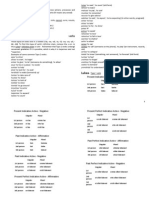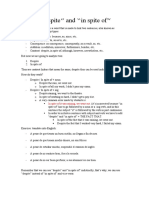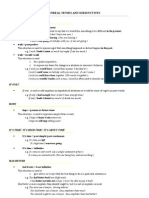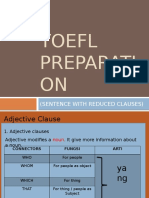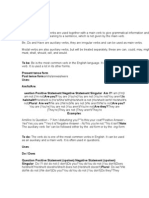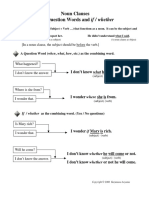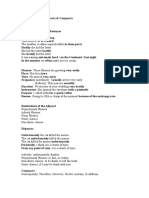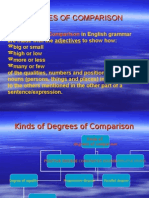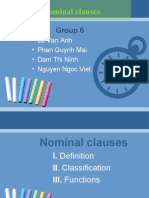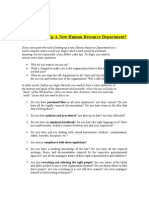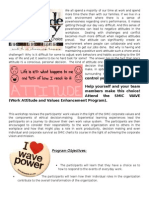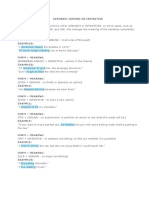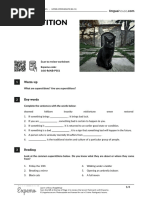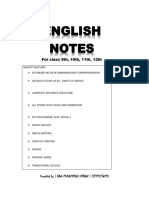Sequence of Tenses
Sequence of Tenses
Uploaded by
Lai RaymundoCopyright:
Available Formats
Sequence of Tenses
Sequence of Tenses
Uploaded by
Lai RaymundoOriginal Description:
Original Title
Copyright
Available Formats
Share this document
Did you find this document useful?
Is this content inappropriate?
Copyright:
Available Formats
Sequence of Tenses
Sequence of Tenses
Uploaded by
Lai RaymundoCopyright:
Available Formats
SEQUENCE OF VERB TENSES
Although the various shades of time and sequence are usually conveyed adequately in informal speech and writing, especially by native speakers and writers, they can create havoc in academic writing and they sometimes are troublesome among students for whom English is a second language. This difficulty is especially evident in complex sentences when there is a difference between the time expressed in an independent clause and the time expressed in a dependent clause. Another difficulty arises with the use of infinitives and participles, modals which also convey a sense of time. We hope the tables below will provide the order necessary to help writers sort out tense sequences. As long as the main clause's verb is in neither the past nor the past perfect tense, the verb of the subordinate clause can be in any tense that conveys meaning accurately. When the main clause verb is in the past or past perfect, however, the verb in the subordinate clause must be in the past or past perfect. The exception to this rule is when the subordinate clause expresses what is commonly known as a general truth:
In the 1950s, English teachers still believed that a background in Latin is essential for an understanding of English. Columbus somehow knew that the world is round. Slaveowners widely understood that literacy among oppressed people is a dangerous thing.
The tables below demonstrate the correct relationship of tenses between clauses where time is of the essence (i.e., within sentences used to convey ideas about actions or conditions that take place over time).
Tense in Purpose of Dependent Clause/ Independent Example(s) Tense in Dependent Clause Clause
Simple Present
To show same-time action, use the present tense To show earlier action, use past
I am eager to go to the concert because I love the Wallflowers. I know that I made the right choice.
tense To show a period of time extending from some point in the past to the They believe that they have elected present, use the present perfect the right candidate. tense. To show action to come, use the future tense. To show another completed past action, use the past tense. The President says that he will veto the bill. I wanted to go home because I missed my parents. She knew she had made the right choice. The Deists believed that the universe is like a giant clock.
Simple Past
To show an earlier action, use the past perfect tense. To state a general truth, use the present tense.
Present Perfect
or For any purpose, use the past tense.
Past Perfect
To show action happening at the same time, use the present tense.
She has grown a foot since she turned nine. The crowd had turned nasty before the sheriff returned.
I will be so happy if they fix my car today. You will surely pass this exam if you studied hard.
Future
To show an earlier action, use the past tense.
To show future action earlier than The college will probably close its the action of the independent doors next summer if enrollments clause, use the present perfect tense. have not increased. Most students will have taken sixty credits by the time they graduate. Most students will have taken sixty credits by the time they have graduated.
Future Perfect
For any purpose, use the present tense or present perfect tense.
Sequence of Tenses With Infinitives and Participles
Like verbs, infinitives and participles are capable of conveying the idea of action in time; therefore, it is important that we observe the appropriate tense sequence when using these modals.
INFINITIVES
Tense of Infinitive Role of Infinitive Example(s)
Present Infinitive (to see)
Coach Espinoza is eager to try out her new drills. [The eagerness is now; the trying out will happen To show same-time action or action later.] later than the verb She would have liked to see more veterans returning. [The present infinitive to see is in the same time as the past would have liked.] The fans would like to have seen some improvement this year. ["Would like" describes a present condition; "to have seen" describes something prior to that time.] They consider the team to have been coached very well. [The perfect infinitive to have been coached indicates a time prior to the verb consider.]
Perfect Infinitive (to have seen)
To show action earlier than the verb
PARTICIPLES
Tense of Participle Role of Participle
To show action occurring at the same time as that of the verb
Example(s)
Working on the fundamentals, the team slowly began to improve. [The action expressed by began happened in the past, at the same time the
Present Participle
(seeing)
working happened.] Prepared by last year's experience, the coach knows not to expect too much. [The action expressed by knows is in the present; prepared expresses a time prior to that time.] Having experimented with several game plans, the coaching staff devised a master strategy. [The present perfect participle having experimented indicates a time prior to the past tense verb, devised.]
Past Participle
or
Present Perfect Participle
To show action occurring earlier than that of the verb
You might also like
- Finnish VerbsDocument23 pagesFinnish VerbsRoshan Budhathoki75% (4)
- Situational LeadershipDocument58 pagesSituational LeadershipLai Raymundo100% (1)
- ADV Manner PDFDocument7 pagesADV Manner PDFFaradilla Bianca SherlyNo ratings yet
- Reduced Adverb ClausesDocument5 pagesReduced Adverb ClausesAna Santos100% (1)
- The Training Cycle Model - Module 2Document6 pagesThe Training Cycle Model - Module 2Lai RaymundoNo ratings yet
- Cornflower TutorialDocument10 pagesCornflower TutorialLai RaymundoNo ratings yet
- Glossary of English Grammar TermsDocument13 pagesGlossary of English Grammar TermsZul HendraNo ratings yet
- Forming Participle ClausesDocument3 pagesForming Participle ClausesMarco FidelNo ratings yet
- Causative VerbsDocument4 pagesCausative VerbsJE RelNo ratings yet
- English Finite and Non Finite VerbsDocument3 pagesEnglish Finite and Non Finite VerbsSona Meiyappan100% (1)
- What Is The Order of Adverbs?Document4 pagesWhat Is The Order of Adverbs?Tuấn Vũ VănNo ratings yet
- Gerunds and InfinitivesDocument10 pagesGerunds and InfinitivesNguyễn BìnhNo ratings yet
- 16 Tenses in English GrammarDocument4 pages16 Tenses in English GrammarsaputriNo ratings yet
- Present Perfect TenseDocument4 pagesPresent Perfect TenseRuthica MANo ratings yet
- A University Grammar of English: Randolph Quirk Sidney GreenbaumDocument32 pagesA University Grammar of English: Randolph Quirk Sidney GreenbaumLeoDavidNo ratings yet
- Adverbial Clauses and ConjunctionsDocument9 pagesAdverbial Clauses and ConjunctionsAiza San Pedro SantosNo ratings yet
- TensesDocument15 pagesTensesrahimi670% (1)
- "Despite" and "In Spite Of"Document2 pages"Despite" and "In Spite Of"luci prNo ratings yet
- Adverb Clauses of ResultDocument1 pageAdverb Clauses of ResultRaso RasovicNo ratings yet
- 8+9. The Article With Countable+Uncountable NounsDocument12 pages8+9. The Article With Countable+Uncountable NounsD1chuNo ratings yet
- The Forms of InfinitiveDocument10 pagesThe Forms of Infinitiveprodaja47No ratings yet
- Relative ClausesDocument2 pagesRelative ClausesjsierrahNo ratings yet
- Unreal Tenses and SubjunctivesDocument3 pagesUnreal Tenses and SubjunctivesBMWuB100% (1)
- Adverb Phrase & ClauseDocument8 pagesAdverb Phrase & Clauseammar_galgulNo ratings yet
- Perfect InfinitiveDocument2 pagesPerfect InfinitiveAdam Smith0% (1)
- Gerund & InfinitiveDocument23 pagesGerund & InfinitiveGemma Castillo100% (1)
- Nominal ClausesDocument4 pagesNominal ClausesAlina Florica100% (1)
- INVERSION ExplainedDocument77 pagesINVERSION Explainedmichele100% (1)
- Present and Past HabitsDocument8 pagesPresent and Past HabitsDespina Trajkova GochevskiNo ratings yet
- PrepositionsDocument5 pagesPrepositionsCinthyaNo ratings yet
- Participle ClausesDocument9 pagesParticiple ClausesSneha NairNo ratings yet
- 10-11. Modals To Express Degrees of Certainty PDFDocument26 pages10-11. Modals To Express Degrees of Certainty PDFFernanda Geraldine CUBA HERRERANo ratings yet
- DeterminerDocument8 pagesDeterminerpreethamNo ratings yet
- Participles and Gerunds Exercise: AnswersDocument2 pagesParticiples and Gerunds Exercise: AnswersRidwan Agustian100% (1)
- Grammar - Future Will and Going ToDocument32 pagesGrammar - Future Will and Going ToJenny BautistaNo ratings yet
- Gerunds and Infinitive PhrasesDocument3 pagesGerunds and Infinitive PhrasesTali SamudioNo ratings yet
- PARTICIPLE CLAUSEsDocument9 pagesPARTICIPLE CLAUSEsMiriam Chiovetta100% (1)
- Clause (Adjective+Adverb)Document13 pagesClause (Adjective+Adverb)Yugi Supriatna100% (1)
- Complete Grammar BookDocument101 pagesComplete Grammar Bookmapuchess100% (1)
- English PrepositionsDocument4 pagesEnglish PrepositionsdianaNo ratings yet
- Not Only But Also: InversionDocument6 pagesNot Only But Also: InversionSlobodan Kanza KanovicNo ratings yet
- Gerunds and Infinitives NewDocument7 pagesGerunds and Infinitives NewMaizura IsmailNo ratings yet
- Adverbial Clauses of Time 1Document15 pagesAdverbial Clauses of Time 1Julissa Sierra QuispeNo ratings yet
- Future Tenses ChartDocument2 pagesFuture Tenses ChartSonia GabaldonNo ratings yet
- Relative ClausesDocument28 pagesRelative ClausesBobana Knezevic100% (1)
- BasicsentenceDocument61 pagesBasicsentenceOkan Emanet100% (1)
- Future TenseDocument31 pagesFuture TenseFitarani0% (1)
- Auxiliary VerbsDocument7 pagesAuxiliary VerbsBhavesh BansalNo ratings yet
- Subject-Verb Agreement: Grammar Practice WorksheetsDocument16 pagesSubject-Verb Agreement: Grammar Practice Worksheetsnatasha100% (1)
- Participle ClauseDocument6 pagesParticiple ClauseJulio100% (1)
- Noun ClausesDocument3 pagesNoun ClausesEFRAIN EDUARDO SORIA TOPA100% (1)
- FINITE AND NON-finite VerbsDocument2 pagesFINITE AND NON-finite VerbsBhavika KaraniNo ratings yet
- Gerund StsDocument43 pagesGerund StsMustafa ÇamNo ratings yet
- List of Verbs Followed by Either Gerunds OR InfinitivesDocument3 pagesList of Verbs Followed by Either Gerunds OR InfinitivesenesusNo ratings yet
- English Syntax - Adjuncts Disjuncts ConjunctsDocument4 pagesEnglish Syntax - Adjuncts Disjuncts ConjunctsrandomeoNo ratings yet
- How To Teach Prepositions of PlaceDocument4 pagesHow To Teach Prepositions of Placeapi-252821028100% (1)
- Adjectives of QualityDocument4 pagesAdjectives of QualityFaizah FaizNo ratings yet
- Degrees of ComparisonDocument23 pagesDegrees of ComparisonNatasha Kalanchina100% (1)
- The Position of Adverbs in SentencesDocument2 pagesThe Position of Adverbs in SentencesCasimiro LuengoNo ratings yet
- The Use of Verb Tenses: The Present Simple TenseDocument8 pagesThe Use of Verb Tenses: The Present Simple TenseSzabo FlorinaNo ratings yet
- Nominal ClausesDocument2 pagesNominal Clausesconstantinescu ancaNo ratings yet
- Modal Verbs TableDocument2 pagesModal Verbs TableЕленаNo ratings yet
- Adverb Clause of ComparisonDocument1 pageAdverb Clause of ComparisonAnees AhmedNo ratings yet
- Nominal Clause (That Clause & Interrogative Clause)Document16 pagesNominal Clause (That Clause & Interrogative Clause)Pm HermioneNo ratings yet
- English Grammar - Sequence of Verb TensesDocument4 pagesEnglish Grammar - Sequence of Verb TensesChiby MirikitufuNo ratings yet
- How To Set Up HR DeptDocument4 pagesHow To Set Up HR DeptDashanandNo ratings yet
- Corporate Image Development 2Document73 pagesCorporate Image Development 2Lai Raymundo100% (1)
- Philippine Australia Human Resource Development Facility: Course OutlineDocument2 pagesPhilippine Australia Human Resource Development Facility: Course OutlineLai RaymundoNo ratings yet
- HARD GoalsDocument3 pagesHARD GoalsLai RaymundoNo ratings yet
- Presentation Title: My Name My Position, Contact Information or Project DescriptionDocument144 pagesPresentation Title: My Name My Position, Contact Information or Project DescriptionLai RaymundoNo ratings yet
- 16 Lessons in Transforming CultureDocument7 pages16 Lessons in Transforming CultureLai RaymundoNo ratings yet
- Strategic Prospecting 2Document34 pagesStrategic Prospecting 2Lai RaymundoNo ratings yet
- Corporate Image Development 2Document73 pagesCorporate Image Development 2Lai Raymundo100% (1)
- WAVE FlyerDocument2 pagesWAVE FlyerLai RaymundoNo ratings yet
- Activities: The Team Responsibility Game Objectives: To Encourage The Sense of Responsibility To Assigned Task and To The Team Members MaterialsDocument5 pagesActivities: The Team Responsibility Game Objectives: To Encourage The Sense of Responsibility To Assigned Task and To The Team Members MaterialsLai RaymundoNo ratings yet
- 16 Lessons in Transforming CultureDocument7 pages16 Lessons in Transforming CultureLai RaymundoNo ratings yet
- OD & Change Plan: Client/Organization Participant/Name DateDocument15 pagesOD & Change Plan: Client/Organization Participant/Name DateLai RaymundoNo ratings yet
- WAVE Final2db (Autosaved)Document50 pagesWAVE Final2db (Autosaved)Lai RaymundoNo ratings yet
- Emotional Intelligence in LeadershipDocument14 pagesEmotional Intelligence in LeadershipLai RaymundoNo ratings yet
- Accounting AssistantDocument2 pagesAccounting AssistantLai RaymundoNo ratings yet
- Afternoon Icebreaker: You Will SayDocument6 pagesAfternoon Icebreaker: You Will SayLai RaymundoNo ratings yet
- Basic Organizational Plans: DIRECT (Deductive) APPROACH Direct-Request PlanDocument9 pagesBasic Organizational Plans: DIRECT (Deductive) APPROACH Direct-Request PlanLai RaymundoNo ratings yet
- Strategic SellingDocument87 pagesStrategic SellingLai Raymundo100% (2)
- Spanish 1 TopicsDocument1 pageSpanish 1 TopicsJoaquinNo ratings yet
- Infinitive and GerundDocument2 pagesInfinitive and Gerundtlinhchi10No ratings yet
- Tech Savvy?: Language NotesDocument13 pagesTech Savvy?: Language NotesArielNo ratings yet
- Phrase DefinitionDocument5 pagesPhrase DefinitionFailan MendezNo ratings yet
- Irregular Verbs Family GroupsDocument1 pageIrregular Verbs Family GroupsAbdellah LabybNo ratings yet
- Gerund or InfinitiveDocument2 pagesGerund or InfinitiveEdward GrossNo ratings yet
- Basic English Grammar Class 5Document9 pagesBasic English Grammar Class 5kingjordi82No ratings yet
- Grade 5 Unit 3 (Lesson2) 1Document15 pagesGrade 5 Unit 3 (Lesson2) 1txt5342019No ratings yet
- Holy Child of Mary College Sto. Niño, Masantol Pampanga 6 Monthly Exam in English 10Document4 pagesHoly Child of Mary College Sto. Niño, Masantol Pampanga 6 Monthly Exam in English 10paul john macasaNo ratings yet
- What Does Basic Sentence Pattern MeanDocument3 pagesWhat Does Basic Sentence Pattern Meanmcheche12No ratings yet
- Listening Work SPEAKING Priorities: A. Look at The Picture Story. Match Sentences A-I WithDocument9 pagesListening Work SPEAKING Priorities: A. Look at The Picture Story. Match Sentences A-I WithMARLON JAFETH GUTIERREZ VASQUEZNo ratings yet
- Nominal Clause (Definition) A Clause Work As A Noun Nominal ClausesDocument3 pagesNominal Clause (Definition) A Clause Work As A Noun Nominal ClausesDanielle KristevaNo ratings yet
- Regular & Irregular VerbsDocument3 pagesRegular & Irregular VerbsBelem RodríguezNo ratings yet
- Universitas Prima Indonesia 2018: Bahasa Inggris Bisnis Ii Pertemuan IIDocument19 pagesUniversitas Prima Indonesia 2018: Bahasa Inggris Bisnis Ii Pertemuan IIRiandy LiuNo ratings yet
- Superstition British English Teacher Ver2 BWDocument6 pagesSuperstition British English Teacher Ver2 BWEnrique Fernandez Perez100% (1)
- GrammarDocument84 pagesGrammarEman AleemNo ratings yet
- Causative Verb: by Madan Sharma Nexus International AcademyDocument11 pagesCausative Verb: by Madan Sharma Nexus International AcademyMadan SharmaNo ratings yet
- Grammar Reference C1.2 U3Document2 pagesGrammar Reference C1.2 U3guijosa.soriaNo ratings yet
- Primary English Knowledge and UnderstandingDocument13 pagesPrimary English Knowledge and UnderstandingmeethisupariiiNo ratings yet
- Oxford Practice Grammar: Second EditionDocument4 pagesOxford Practice Grammar: Second Editiondearprasanta60150% (1)
- Grade 9 SLM Third QuarterDocument100 pagesGrade 9 SLM Third Quarterunicaeli2020No ratings yet
- CP English Test - 2020-21 - Módulo 2Document4 pagesCP English Test - 2020-21 - Módulo 2Paulo AmaralNo ratings yet
- 88 Gerunds-and-Infinitives US StudentDocument15 pages88 Gerunds-and-Infinitives US StudentAlfredo Balcázar0% (2)
- (Master The Basics) Christopher Kendris - Spanish-Barron's Educational (1987)Document212 pages(Master The Basics) Christopher Kendris - Spanish-Barron's Educational (1987)Camilo Adrián Frías Tilton100% (1)
- The Perfect Infinitive WebDocument2 pagesThe Perfect Infinitive WebEugenia DvortsovaNo ratings yet
- لقطة شاشة 2023-12-20 في 2.05.47 صDocument9 pagesلقطة شاشة 2023-12-20 في 2.05.47 ص89s56j8xqhNo ratings yet
- Unit 1 To + InfinitiveDocument3 pagesUnit 1 To + InfinitivehendinchangNo ratings yet
- Basic English Grammar Oo1Document43 pagesBasic English Grammar Oo1AL'vhanz FreezyNo ratings yet
